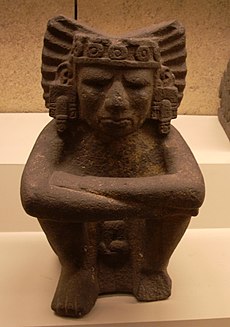Our website is made possible by displaying online advertisements to our visitors.
Please consider supporting us by disabling your ad blocker.
Xiuhtecuhtli
| Xiuhtecuhtli | |
|---|---|
Father of the gods God of fire | |
 Xiuhtēcuhtli as depicted in the Codex Borgia | |
| Other names | Totahtzin, Īxcōzauhqui, Huēhuehtēōtl, Cuezaltzin |
| Abode | • Ilhuicatl-Teotlatlauhco (Eleventh Heaven) • Calpulli (the center of the four cardinal directions) |
| Gender | Male |
| Region | Mesoamerica |
| Ethnic group | Aztec (Nahua) |
| Genealogy | |
| Parents | Created by the Tezcatlipocas[1] (Codex Zumarraga) |
| Siblings | None |
| Consort | Chāntico (Codex Zumarraga)[1] |
| Children | With Chāntico: Xiuhxoxoauhqui (blue fire), Xiuhcozauhqui (yellow fire), Xiuhiztac (white fire) and Xiuhtlatlauhqui (red fire)[1] |
| Equivalents | |
| Maya | K'awiil (God K) |

In Aztec mythology, Xiuhtēcuhtli [ʃiʍˈteːkʷt͡ɬi] ("Turquoise Lord" or "Lord of Fire"),[3] was the god of fire, day and heat.[4] In historical sources he is called by many names, which reflect his varied aspects and dwellings in the three parts of the cosmos.[5] He was the lord of volcanoes,[6] the personification of life after death, warmth in cold (fire), light in darkness and food during famine. He was also named Cuezaltzin [kʷeˈs̻aɬt͡sin̥] ("flame") and Ixcozauhqui [iːʃkoːˈsaʍkiˀ],[7] and is sometimes considered to be the same as Huehueteotl ("Old God"),[8] although Xiuhtecuhtli is usually shown as a young deity.[9] His wife was Chalchiuhtlicue. Xiuhtecuhtli is sometimes considered to be a manifestation of Ometecuhtli, the Lord of Duality, and according to the Florentine Codex Xiuhtecuhtli was considered to be the father of the Gods,[10] who dwelled in the turquoise enclosure in the center of earth.[11] Xiuhtecuhtli-Huehueteotl was one of the oldest and most revered of the indigenous pantheon.[12] The cult of the God of Fire, of the Year, and of Turquoise perhaps began as far back as the middle Preclassic period.[13] Turquoise was the symbolic equivalent of fire for Aztec priests.[14] A small fire was permanently kept alive at the sacred center of every Aztec home in honor of Xiuhtecuhtli.[14]
The Nahuatl word xihuitl means "year" as well as "turquoise" and "fire",[11] and Xiuhtecuhtli was also the god of the year and of time.[15][16] The Lord of the Year concept came from the Aztec belief that Xiuhtecuhtli was the North Star.[17] In the 260-day ritual calendar, the deity was the patron of the day Atl ("Water") and with the trecena 1 Coatl ("1 Snake").[15] Xiuhtecuhtli was also one of the nine Lords of the Night and ruled the first hour of the night, named Cipactli ("Alligator").[18] Scholars have long emphasized that this fire deity also has aquatic qualities.[13] Xiuhtecuhtli dwelt inside an enclosure of turquoise stones, fortifying himself with turquoise bird water.[19] He is the god of fire in relation to the cardinal directions, just as the brazier for lighting fire is the center of the house or temple.[20] Xiuhtecuhtli was the patron god of the Aztec emperors, who were regarded as his living embodiment at their enthronement.[21] The deity was also one of the patron gods of the pochteca merchant class.[22]
Stone sculptures of Xiuhtecuhtli were ritually buried as offerings, and various statuettes have been recovered during excavations at the Great Temple of Tenochtitlan with which he was closely associated.[23] Statuettes of the deity from the temple depict a seated male with his arms crossed.[24] A sacred fire was always kept burning in the temples of Xiuhtecuhtli.[25] In gratitude for the gift of fire, the first mouthful of food from each meal was flung into the hearth.[21]
Xiuhtecuhtli is depicted in the Codex Borgia.[26]
- ^ a b c Cecilio A. Robelo (1905). Diccionario de Mitología Nahoa (in Spanish). Editorial Porrúa. p. 351. ISBN 970-07-3149-9.
- ^ Website of the British Museum. Archived May 23, 2011, at the Wayback Machine
- ^ Fernández 1992, 1996, p.104. Matos Moctezuma & Solis Olguín 2002, p.476. Miller & Taube 1993, 2003, p.189.
- ^ Matos Moctezuma & Solis Olguín 2002, p.433.
- ^ Olvera, Silvia Limón. "Fire Deities." In David Carrasco (ed).The Oxford Encyclopedia of Mesoamerican Cultures. : Oxford University Press, 2001
- ^ Coe & Koontz 2002, p.55.
- ^ Sahagún 1577, 1989, p.47. (Book I, Chapter XIII).
- ^ Fernández 1992, 1996, p.104.
- ^ Matos Moctezuma & Solis Olguín 2002, p.476.
- ^ Fernández 1992, 1996, p.104. León-Portilla 2002, pp.25, 26.
- ^ a b Matos Moctezuma 1988, p.94.
- ^ Luján 2005, p.140
- ^ a b Luján 2005, p.141
- ^ a b Roy 2005, p.211
- ^ a b Miller & Taube 1993, 2003, p.190. Smith 1996, 2003, pp.246-7. Díaz & Rodgers 1993, p.xix.
- ^ Bezanilla 2000, p.25
- ^ Bingham & Roberts 2010, p.143
- ^ Díaz & Rodgers 1993, p.xix. Smith 1996, 2003, p.248
- ^ Luján 2005, p.145.
- ^ Luján 2005, p.147.
- ^ a b Matos Moctezuma & Solis Olguín 2002, p.447.
- ^ Coe & Koontz 2002, p.197.
- ^ Matos Moctezuma & Solis Olguín 2002, pp.172, 476.
- ^ Matos Moctezuma & Solis Olguín 2002, p.172.
- ^ Matos Moctezuma & Solis Olguín 2002, p.414.
- ^ Diaz, Gisele; Rodgers, Alan. The Codex Borgia: A Full-Color Restoration of the Ancient Mexican Manuscript. Dover. ISBN 9780486275697.
Previous Page Next Page


